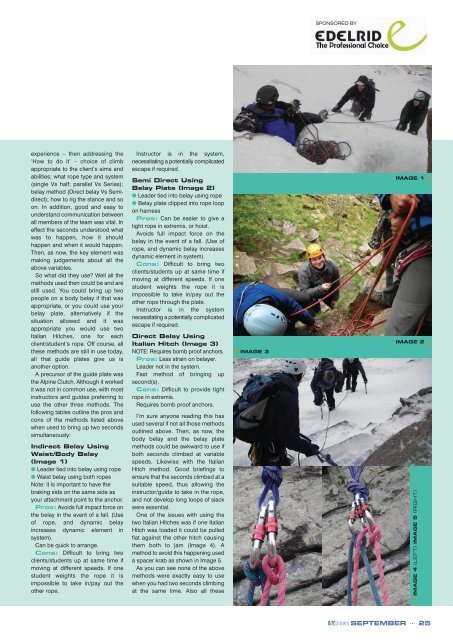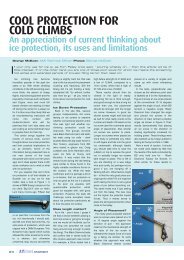WHAT'S SO MAGIC ABOUT MAGIC PLATES? - Glenmore Lodge
WHAT'S SO MAGIC ABOUT MAGIC PLATES? - Glenmore Lodge
WHAT'S SO MAGIC ABOUT MAGIC PLATES? - Glenmore Lodge
Create successful ePaper yourself
Turn your PDF publications into a flip-book with our unique Google optimized e-Paper software.
experience – then addressing the<br />
‘How to do it’ – choice of climb<br />
appropriate to the client’s aims and<br />
abilities; what rope type and system<br />
(single Vs half; parallel Vs Series);<br />
belay method (Direct belay Vs Semidirect);<br />
how to rig the stance and so<br />
on. In addition, good and easy to<br />
understand communication between<br />
all members of the team was vital. In<br />
effect the seconds understood what<br />
was to happen, how it should<br />
happen and when it would happen.<br />
Then, as now, the key element was<br />
making judgements about all the<br />
above variables.<br />
So what did they use? Well all the<br />
methods used then could be and are<br />
still used. You could bring up two<br />
people on a body belay if that was<br />
appropriate, or you could use your<br />
belay plate, alternatively if the<br />
situation allowed and it was<br />
appropriate you would use two<br />
Italian Hitches, one for each<br />
client/student’s rope. Off course, all<br />
these methods are still in use today,<br />
all that guide plates give us is<br />
another option.<br />
A precursor of the guide plate was<br />
the Alpine Clutch. Although it worked<br />
it was not in common use, with most<br />
instructors and guides preferring to<br />
use the other three methods. The<br />
following tables outline the pros and<br />
cons of the methods listed above<br />
when used to bring up two seconds<br />
simultaneously:<br />
Indirect Belay Using<br />
Waist/Body Belay<br />
(Image 1)<br />
● Leader tied into belay using rope<br />
● Waist belay using both ropes<br />
Note: it is important to have the<br />
braking side on the same side as<br />
your attachment point to the anchor.<br />
Pros: Avoids full impact force on<br />
the belay in the event of a fall. (Use<br />
of rope, and dynamic belay<br />
increases dynamic element in<br />
system).<br />
Can be quick to arrange.<br />
Cons: Difficult to bring two<br />
clients/students up at same time if<br />
moving at different speeds. If one<br />
student weights the rope it is<br />
impossible to take in/pay out the<br />
other rope.<br />
Instructor is in the system,<br />
necessitating a potentially complicated<br />
escape if required.<br />
Semi Direct Using<br />
Belay Plate (Image 2)<br />
● Leader tied into belay using rope<br />
● Belay plate clipped into rope loop<br />
on harness<br />
Pros: Can be easier to give a<br />
tight rope in extremis, or hoist.<br />
Avoids full impact force on the<br />
belay in the event of a fall. (Use of<br />
rope, and dynamic belay increases<br />
dynamic element in system).<br />
Cons: Difficult to bring two<br />
clients/students up at same time if<br />
moving at different speeds. If one<br />
student weights the rope it is<br />
impossible to take in/pay out the<br />
other rope through the plate.<br />
Instructor is in the system<br />
necessitating a potentially complicated<br />
escape if required.<br />
Direct Belay Using<br />
Italian Hitch (Image 3)<br />
NOTE: Requires bomb proof anchors.<br />
Pros: Less strain on belayer.<br />
Leader not in the system.<br />
Fast method of bringing up<br />
second(s).<br />
Cons: Difficult to provide tight<br />
rope in extremis.<br />
Requires bomb proof anchors.<br />
I’m sure anyone reading this has<br />
used several if not all those methods<br />
outlined above. Then, as now, the<br />
body belay and the belay plate<br />
methods could be awkward to use if<br />
both seconds climbed at variable<br />
speeds. Likewise with the Italian<br />
Hitch method. Good briefings to<br />
ensure that the seconds climbed at a<br />
suitable speed, thus allowing the<br />
instructor/guide to take in the rope,<br />
and not develop long loops of slack<br />
were essential.<br />
One of the issues with using the<br />
two Italian Hitches was if one Italian<br />
Hitch was loaded it could be pulled<br />
flat against the other hitch causing<br />
them both to jam (Image 4). A<br />
method to avoid this happening used<br />
a spacer krab as shown in Image 5.<br />
As you can see none of the above<br />
methods were exactly easy to use<br />
when you had two seconds climbing<br />
at the same time. Also all these<br />
▲<br />
IMAGE 3<br />
SPON<strong>SO</strong>RED BY<br />
IMAGE 1 ▲<br />
IMAGE 2 ▲<br />
IMAGE 4 (LEFT) IMAGE 5 (RIGHT)<br />
▲<br />
AMInews SEPTEMBER ... 25



